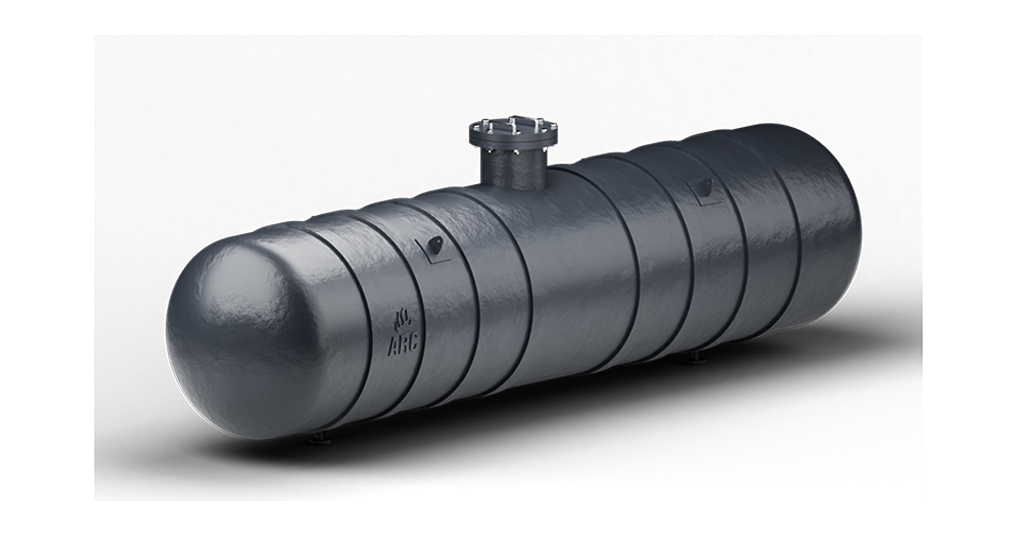FRP tanks, or Fiber-Reinforced Polymer tanks, are storage vessels made from a composite material consisting of reinforcing fibers embedded in a polymer resin matrix. FRP tanks are typically manufactured using a filament winding or hand lay-up process. In filament winding, continuous reinforcing fibers (usually glass or carbon) are wound around a mandrel or liner in a specific pattern, which is then impregnated with a thermoset resin (e.g., polyester, vinyl ester, or epoxy). The resin is then cured, creating a strong, lightweight, and corrosion-resistant tank.
Due to the corrosion resistant nature of FRP, the tank can be made entirely from the composite, or a second liner can be used. In either case, the inner liner is made using different material properties than the structural portion (Hence the name dual (meaning two) and laminate (a word commonly used for a layer of a composite material))
The liner if made of FRP is usually resin rich and utilizes a different type of glass, called “C-Glass”, while the structural portion uses “E-Glass”. The thermoplastic liner is usually 2.3 mm thick (100 mils). This thermoplastic liner is not considered to contribute mechanical strength. The FRP liner is usually cured before winding or lay-up continues, by using either a BPO/DMA system, or using an MEKP catalyst with cobalt in the resin.



FRP tanks are highly resistant to a wide range of chemicals, including acids, alkalis, solvents, crude oil, refined petroleum products, and various oil industry additives.This resistance ensures a longer service life and reduced maintenance costs compared to traditional metallic tanks, which are susceptible to corrosion in such environments.

FRP tanks resist corrosion from chemicals, crude oil, sulfur compounds, salts, acids, and water. This durability extends their lifespan, reduces the risk of leaks or failures, and lowers maintenance costs compared to traditional metallic tanks, making them ideal for storing various substances, including potable and chemically diverse water.

FRP tanks are resistant to fouling, scaling, and buildup, which can reduce the need for frequent cleaning and maintenance. This translates into lower operational costs and fewer disruptions in the chemical, oil & water storage facility.

FRP tanks are lightweight yet possess excellent strength-to-weight ratios, making them easier to install and handle compared to metallic tanks of similar strength. This characteristic can also reduce installation costs and enable the use of smaller support structures.

FRP tanks can be manufactured in a variety of sizes, shapes, and configurations, allowing for customization to meet the specific requirements of chemical, oil & storage facilities. They can also be designed to handle a wide range of pressures and temperatures.

FRP tanks can be designed to meet fire-resistant specifications, making them suitable for use in areas with high fire risk or where fire safety is a critical concern.

FRP tanks have low thermal conductivity, which can help maintain the temperature of the stored chemicals, oil & water reducing heat loss or gain, and improving overall storage efficiency.

FRP tanks can be manufactured as seamless structures, reducing the risk of leaks and minimizing potential weak points compared to welded or riveted metallic tanks.

FRP tanks can be designed to meet stringent environmental regulations and standards, minimizing the risk of leaks or spills that could lead to environmental contamination.

FRP tanks can be manufactured with various linings or coatings to enhance their chemical resistance and compatibility with specific chemicals & water compositions or mixtures.

FRP tanks have a smooth, non-porous surface that inhibits the growth of bacteria, algae, and other microorganisms, making them suitable for storing potable water and meeting hygiene standards.

With proper installation and maintenance, FRP tanks can have a service life of several decades, providing a durable and cost-effective solution for water storage applications.
| PARTICULARS | |
|---|---|
| Type | Horizontal Cylindrical & Vertical Cylindrical |
| End | Dish End, Semi Spherical End, Plain End |
| Length | Customized (3000 mm – 10000 mm |
| MOC | FRP, FRVE, FRE, FR |
| Design Code | BS 4994 |
| Design Temp | 60 Deg C |
| Operating Pressure | Atmospheric |
| Design Pressure | Static Head |
| Operation Temp | Ambient |
| Manufacturing Process | Filament Winding & Hand Lay Up |
| Design Pressure | Atmospheric |
| Tank Capacity | 100 L – 50 KL |
| Extra Features | Nozzle, Manhole, Ladder (Vertical Height), Walkway, Level Indicator, Saddle |
| Application | Water Storage, Chemical Storage, Oil Storage |
| Flange Rating | ANSI B 16.5 #150 |
| PARTICULARS | |
|---|---|
| Barcol Hardness | Min 30 BHU |
| Peel Strength | Min 5 N/mm2 |
| Ultimate Tensile Strength | #200 N/mm Width Per Kg/m2 Glass |
| PARTICULARS | |
|---|---|
| Glass Content | 40% (By Hand lay Up Process) |
| Resin Content | 60% (By Hand Lay Up Process) |

ARC FRP products meet industry standards, ensuring quality and compliance for durability, safety, and performance in construction.
Download
ARC FRP products come with an in-house test certificate documenting performance, quality, and compliance based on internal testing and evaluations.
Download
ARC FRP products come with a third-party test certificate verifying independent assessment of their quality, performance, and adherence to industry standards.
Download